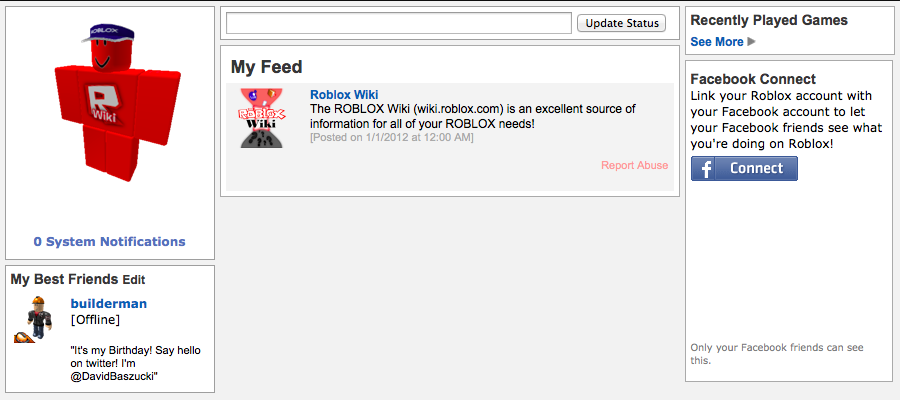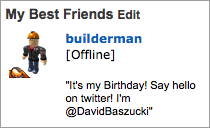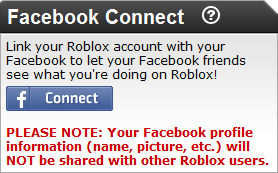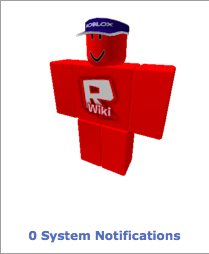>Merlin11188 |
>Merlin11188 |
| (25 intermediate revisions by the same user not shown) |
| Line 1: |
Line 1: |
| {{CatUp|Function Dump}} | | {{User:Merlin11188/Templates/NoEdit}} |
|
| |
|
| ==String Manipulation==
| |
|
| |
|
| This library provides generic functions for string manipulation, such as finding and extracting substrings, and pattern matching. When indexing a string in Lua, the first character is at position 1 (not at 0, as in C). Indices are allowed to be negative and are interpreted as indexing backwards, from the end of the string. Thus, the last character is at position -1, and so on.
| | {{Stub}} |
| | {| |
| | |[[File:Home_Subpage.png|frame|A picture of the 'Home' tab on the submenu in 'My ROBLOX'.]] <br/> |
| | |} |
| | __TOC__ |
|
| |
|
| The string library provides all its functions inside the table string. It also sets a metatable for strings where the __index field points to the string table. Therefore, you can use the string functions in object-oriented style. For instance, string.byte(s, i) can be written as s:byte(i). Parameters written in brackets are optional.
| |
|
| |
|
| | ===Character and Notifications=== |
| | {| |
| | |On the far left of the page there is a picture of [[My_Character|your character]]. Underneath, there is a link to your system notifications. |
| | |[[File:Avatar_Notifications.png|frame|A picture of [[My_Character|your character]] with system notifications beneath it.]] |
| | |} |
|
| |
|
| ===string.byte (''s'' [, ''i'' [, ''j'']])=== | | ===Best Friends=== |
| | {| |
| | |Underneath of your avatar and notification box is your [[Friends#Best_Friends|best friends]] list. Here you can see what your best friends are doing (from their [[My_Home#Status_Update|shout box]]) and whether or not they're online. |
| | |[[File:Best_Friends.png|frame|This a list of your [[Friends#Best_Friends|best friends]] and their most recent shouts!]] |
| | |} |
|
| |
|
| | ===Status Update=== |
| | {| |
| | |You can use this so that people who visit your profile can see what you're up to. |
| | |[[File:Status Update.png|frame|This is the status update bar. People who have you as their [[Friends#Best_Friends|best friend]] will see it on their [[My_Home|home]]!]] |
| | |} |
|
| |
|
| Returns [http://wiki.roblox.com/index.php/Image:Ascii_Table.png ascii values] of the characters ''s[i]'', ''s[i+1]'', all the way until ''s[j]''. The default value for ''i'' is 1; the default value for ''j'' is i.
| | ===Feed=== |
| | {| |
| | |Your feed is in the center of the page, just beneath your status update box. Your feed is a way to keep you updated with all of your groups. Every time someone uses the shout box in one of your [[groups]], you're updated here! |
| | |[[File:Feed bar.png|frame|This is for your feed—all of your [[groups]]' shouts go here.]] |
| | |} |
|
| |
|
| Note that numerical codes are not necessarily portable across platforms.
| | ===Recently Played Games=== |
| | {| |
| | |On the far right is the 'Recently Played Games' box. Your most recently played games can be seen here. If you want a larger list, you can click the '''See More''' button. |
| | |[[File:Recently_Played_Games.png|frame|This is a list of your most recently played [[game]]s.]] |
| | |} |
|
| |
|
| {{Example| | | ===Facebook Connect=== |
| <pre>
| | {| |
| print(string.byte ("d"))
| | |On the far right, underneath of the 'Recently Played Games' box is the Facebook connect box. If you have a Facebook account, you can link it to your ROBLOX account! See [[connecting your account to Facebook]] for more info. |
| print(string.byte ("abc", 1, 3))
| | |[[File:FacebookConnect_Unconnected.png|frame|Facebook connect. You can use this to link your Facebook account to your [[Roblox|ROBLOX]] account! Your personal info will '''not''' be shared with other users!]] |
| | |} |
|
| |
|
| Will result in:
| | <!-- |
| 100
| | {| class="wikitable" style="border-spacing: 0px; padding: 0px;" |
| 97 98 99
| | |- |
| </pre> | | |[[File:Avatar + Notifications]] |
| }}
| | |[[File:Status_Update.png]] |
| | | |[[File:Recently_Played_Games.png|287px]] |
| ===string.char (···)===
| | |- |
| | | |[[File:Best_Friends.png]] |
| | | |<div style="top:0px;">[[File:Feed_bar.png]]</div> |
| Receives zero or more integers. Returns a string with length equal to the number of arguments, in which each character is the [http://wiki.roblox.com/index.php/Image:Ascii_Table.png ascii representation] equal to its corresponding number.
| | |[[File:FacebookConnect_Unconnected.png]] |
| | | |}--> |
| Note that numerical codes are not necessarily portable across platforms.
| |
| | |
| {{Example| | |
| <pre>
| |
| print(string.char (97, 98, 99, 100))
| |
| | |
| Will result in:
| |
| abcd
| |
| </pre>
| |
| }}
| |
| | |
| ===string.dump (''function'')===
| |
| | |
| | |
| Returns a string containing a binary representation of ''function'', so that a later loadstring on this string returns a copy of ''function''. string.dump is commonly used in [[Script Obfuscation|script obfuscation]].
| |
| | |
| {{Example|
| |
| <pre>
| |
| function f ()
| |
| print "hello, world"
| |
| end
| |
| s = string.dump (f)
| |
| assert (loadstring (s)) ()
| |
| | |
| Will result in:
| |
| hello, world [http://www.gammon.com.au/scripts/doc.php?lua=string.dump]
| |
| </pre>
| |
| }}
| |
| | |
| ===string.find (''s'', ''substring'' [, ''init'' [, ''plain'']])===
| |
| | |
| | |
| Looks for the first match of ''substring'' in string ''s''. ''substring'' may be a [[Patterns|pattern]]. If a match is found, then string.find returns the '''locations''' (1, 3, etc.) of ''s'' where this occurrence starts and ends; otherwise, it returns nil. A third, optional numerical argument, ''init'', specifies where to start the search in the string; its default value is 1 and may be negative. A value of true as a fourth, optional argument, ''plain'', turns off the pattern matching facilities, so the function does a plain "find substring" operation, with no characters in pattern being considered "magic" (see [[Patterns|patterns]]). Note that if ''plain'' is given, then ''init'' must be given as well.
| |
| | |
| If ''substring'' has captures, then in a successful match the captured values are also returned, after the two locations.
| |
| | |
| {{Example|
| |
| <pre>
| |
| print(string.find ("blahblah", "bla"))
| |
| | |
| Will result in:
| |
| 1 3
| |
| </pre>
| |
| }}
| |
| | |
| ===string.format (''formatstring'', ···)===
| |
| | |
| Returns a formatted version of its variable number of arguments following the description given in its first argument (which must be a string). Here is a link to [[String Formatting|string formatting]].
| |
| | |
| ===string.len (''s'')===
| |
| | |
| | |
| Receives ''s'' (a string) and returns its length. The empty string "" has length 0. Embedded zeros ([http://wiki.roblox.com/index.php/Image:Ascii_Table.png the null terminator]) are counted, so "a\000bc\000" has length 5.
| |
| | |
| {{Example|
| |
| <pre>
| |
| print(string.len (""))
| |
| print(string.len ("a"))
| |
| print(string.len ("ab"))
| |
| print(string.len ("abc"))
| |
| | |
| Will result in:
| |
| 0
| |
| 1
| |
| 2
| |
| 3
| |
| </pre>
| |
| }}
| |
| | |
| ===string.lower (''s'')===
| |
| | |
| | |
| Receives ''s'' (a string) and returns a copy of ''s'' with all uppercase letters changed to lowercase. All other characters are left unchanged.
| |
| | |
| {{Example|
| |
| <pre>
| |
| print(string.lower ("Hi Mom!"))
| |
| | |
| Will result in:
| |
| hi mom!
| |
| </pre>
| |
| }}
| |
| | |
| ===string.match (''s'', ''pattern'' [, ''init''])===
| |
| | |
| | |
| Looks for the first match of string ''pattern'' in string ''s''. If it finds one, then match returns the captures from ''pattern''; otherwise, it returns nil. If ''pattern'' specifies no captures (see [[Patterns#Captures|pattern captures]]), then the whole match is returned. A third, optional numerical argument ''init'' specifies where to start the search; its default value is 1 and may be negative. A series of dots (...) represent unknown characters; they will match anything.
| |
| | |
| {{Example|
| |
| <pre>
| |
| print (string.match ("I like pepperoni pizza", "pi.."))
| |
| | |
| Will result in:
| |
| pizz
| |
| </pre>
| |
| }}
| |
| | |
| In the above example, the pi.. represented a string that started with pi and the next two characters; hence the two dots. Note that this overwrites the character class . (see [[Patterns|patterns]]).
| |
| | |
| ===string.rep (''s'', ''n'')===
| |
| | |
| | |
| Returns a string that is the combination of ''n'' copies of the string ''s''.
| |
| | |
| {{Example|
| |
| <pre>
| |
| a=string.rep ("Blarg, ", 4)
| |
| print(a)
| |
| | |
| Will result in:
| |
| Blarg, Blarg, Blarg, Blarg,
| |
| </pre>
| |
| }}
| |
| | |
| | |
| ===string.reverse (''s'')===
| |
| | |
| | |
| Returns a string that is the string ''s'' reversed.
| |
| | |
| {{Example|
| |
| <pre>
| |
| print(string.reverse ("!moM ,olleH"))
| |
| | |
| Will result in:
| |
| Hello, Mom!
| |
| </pre>
| |
| }}
| |
| | |
| | |
| ===string.sub (''s'', ''i'' [, ''j''])===
| |
| | |
| | |
| Returns the substring of ''s'' that starts at ''i'' and continues until ''j''; ''i'' and ''j'' may be negative. If ''j'' is absent, then it is assumed to be equal to the length of ''s''. In particular, the call string.sub(''s'',1,''j'') returns ''s'' until as many characters as ''j'', and string.sub(''s'', -''i'') returns a suffix of ''s'' with length ''i''.
| |
| | |
| {{Example|
| |
| <pre>
| |
| print(string.sub ("Hi Mom!", 1, 4))
| |
| | |
| Will result in:
| |
| Hi M
| |
| </pre>
| |
| <pre>
| |
| print(string.sub ("Hi Mom!", 2))
| |
| | |
| Will result in
| |
| i Mom!
| |
| </pre>
| |
| }}
| |
| | |
| ===string.upper (''s'')===
| |
| | |
| | |
| Receives a string and returns a copy of this string with all lowercase letters changed to uppercase. All other characters are left unchanged.
| |
| | |
| {{Example|
| |
| <pre>
| |
| print(string.upper ("Hi Mom!"))
| |
| | |
| Will result in:
| |
| HI MOM!
| |
| </pre>
| |
| }}
| |
| | |
| ===Patterns===
| |
| [[Patterns]] | |
| | |
| [[String_Patterns|A Beginner's Guide to String Patterns]]
| |
| | |
| ===string.gmatch (''s'', [[Patterns|''pattern'']])===
| |
| | |
| | |
| Returns an iterator function that, each time it is called, returns the next captures from [[Patterns|''pattern'']] over string ''s''. If ''pattern'' specifies no captures (see [[Patterns#Captures|captures]]), then the whole match is produced in each call.
| |
| | |
| As an example, the following loop:
| |
| | |
| <pre> | |
| s = "hello world from Lua"
| |
| for w in string.gmatch(s, "%a+") do
| |
| print(w)
| |
| end
| |
| </pre>
| |
| | |
| will iterate over all the words from string ''s'', printing one per line. The next example collects all pairs index=value from the given string into a table:
| |
| | |
| <pre>
| |
| t = {}
| |
| s = "from=world, to=Lua"
| |
| for k, v in string.gmatch(s, "(%w+)=(%w+)") do -- k and v are the returned captures
| |
| t[k] = v
| |
| end
| |
| </pre>
| |
| | |
| For this function, a '^' at the start of [[Patterns|''pattern'']] does not work as an anchor, as this would prevent the iteration. Here are some examples:
| |
| {{Example|<pre>
| |
| local t={}
| |
| for matchedValue in string.gmatch("alphabet and numbers 1234-4321", "a") do -- Search for a in that string
| |
| table.insert(t,matchedValue)
| |
| end
| |
| print(#t.." a's were found!")
| |
| Output:
| |
| 3 a's were found!
| |
| </pre>
| |
| <br/>
| |
| <pre>
| |
| for x in string.gmatch("Numbers", "b") do -- Search for b in Numbers
| |
| print(x)
| |
| end
| |
| | |
| Output:
| |
| b
| |
| </pre>}}
| |
| | |
| Alright, that was searching for plain text. Here are some examples with [[Patterns|patterns]]:
| |
| | |
| {{Example|
| |
| <pre>
| |
| for q in string.gmatch ("send money mom", "%a+") do
| |
| print (q)
| |
| end
| |
| | |
| Output:
| |
| send
| |
| money
| |
| mom
| |
| </pre>
| |
| <br/>
| |
| <pre>
| |
| for value in string.gmatch("Once upon a time, there were 34 fairies, 20 of which were smart.", "%d+") do -- Find numbers
| |
| print("At least "..value.." of the fairies are magical.")
| |
| end
| |
| | |
| Output:
| |
| At least 34 of the fairies are magical.
| |
| At least 20 of the fairies are magical.
| |
| </pre>
| |
| <br/>
| |
| <pre>
| |
| for q in string.gmatch("My name is merlin11188", "(%a+)%d+") do
| |
| print("The letter part of my name is "..q)
| |
| end
| |
| | |
| Output:
| |
| The letter part of my name is merlin
| |
| </pre> | |
| }}
| |
| | |
| ===string.gsub (''s'', [[Patterns|''pattern'']], ''repl'' [, ''n''])===
| |
| | |
| | |
| Returns a copy of ''s'' in which all (or the first ''n'', if given) occurrences of ''pattern'' have been replaced by replacement string ''repl'', which may be a string, a table, or a function. string.gsub also returns, as its second value, the total number of matches that occurred.
| |
| | |
| If ''repl'' is a string, then its value is used for replacement. The character % works as an escape character: any sequence in ''repl'' of the form %n, with n between 1 and 9, stands for the value of the n-th captured substring (see [[Patterns#Captures|pattern captures]]). The sequence %0 stands for the whole match.
| |
| | |
| If ''repl'' is a table, then the table is queried for every match, using the first capture as the key; if ''pattern'' specifies no captures, then the whole match is used as the key.
| |
| | |
| If ''repl'' is a function, then this function is called every time a match occurs, with all captured substrings passed as arguments, in order; if ''pattern'' specifies no captures, then the whole match is passed as the sole argument.
| |
| | |
| If the value returned by the table query or by the function call is a string or a number, then it is used as the replacement string; otherwise, if it is false or nil, then there is no replacement (that is, the original match is kept in the string).
| |
| | |
| Here are some examples using plain character replacement:
| |
| {{Example|<pre>
| |
| x = string.gsub("hello world", "hello", "goodbye")
| |
| --> x="goodbye world"
| |
|
| |
| x = string.gsub("Bonjour!", "Bonjour", "Hello")
| |
| --> x="Hello!"
| |
| | |
| x = string.gsub("Avada Kedavra", "Avada Kedavra", "Abracadabra")
| |
| --> x="Abracadabra"
| |
| | |
| x = string.gsub("I like to munch numbers 1234", "1234", "and words.")
| |
| --> x="I like to munch numbers and words.")
| |
| </pre>}}
| |
| Those were all examples using plain character replacements. Here are some using [[Patterns|patterns]]:
| |
| | |
| {{Example|<pre>
| |
| x = string.gsub("I found an imaginary hex number: F243BC234AD234Ei", "%x+i", "Yeah right. That's not real.")
| |
| --> x="I found an imaginary hex number: Yeah right. That's not real."
| |
|
| |
| x = string.gsub("home = $HOME, user = $USER", "%$(%w+)", {USER="Merlin", HOME="AWESOME"})
| |
| --> x="home = AWESOME, user = Merlin"
| |
|
| |
| x = string.gsub("4+5 = $return 4+5$", "%$(.-)%$", function (s)
| |
| return loadstring(s)()
| |
| end)
| |
| --> x="4+5 = 9"
| |
| | |
| x = string.gsub("hello world from Lua", "(%w+)%s*(%w+)", "%2 %1")
| |
| --> x="world hello Lua from"
| |
|
| |
| local t = {name="lua", version="5.1"}
| |
| x = string.gsub("$name-$version.tar.gz", "%$(%w+)", t)
| |
| --> x="lua-5.1.tar.gz"
| |
| | |
| </pre>}}
| |
| | |
| ===See Also===
| |








